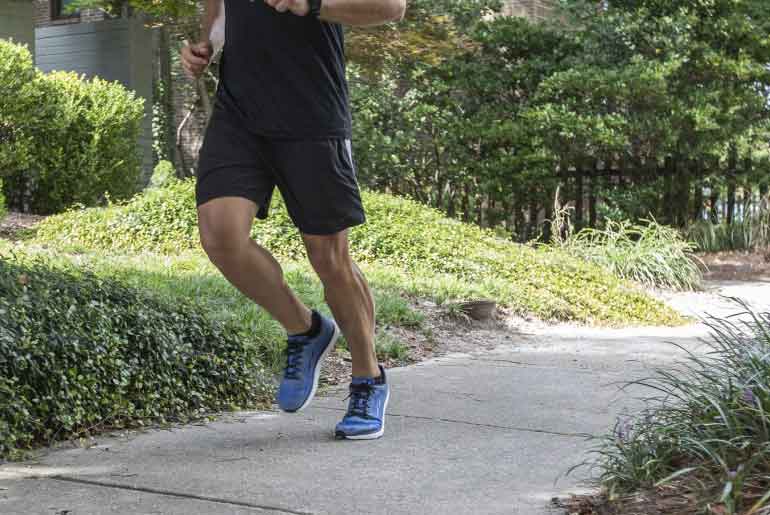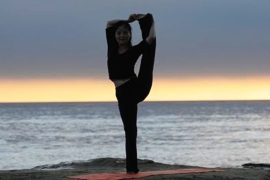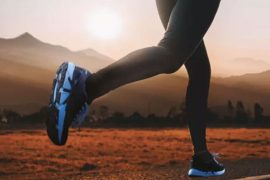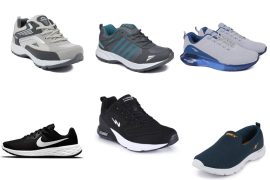Athletic Shoes:
Choosing the right athletic shoes are crucial for comfort, performance, and injury prevention, especially given the impact sports can have on the feet, ankles, and legs. Different sports and activities require specific types of shoes designed to provide appropriate support, cushioning, and stability. For instance, running shoes are engineered to absorb impact and support forward motion, while court shoes offer lateral support for activities like tennis or basketball.
Cleats are essential for traction in sports like soccer or football, and hiking shoes provide stability and durability on rough terrain. If you engage in multiple types of exercises regularly, a cross-training shoe can offer versatility across different activities. Investing in shoes tailored to your primary sport or activity frequency can significantly enhance your overall athletic experience and reduce the risk of injury.
Finding the right athletic shoes:
Finding the right athletic shoe is crucial for comfort, performance, and injury prevention. Here are some tips based on your query:
- Shop at Specialty Stores: If possible, go to stores that specialize in the sport you participate in (e.g., running store for runners, tennis shop for tennis players). They have knowledgeable staff who can guide you to the right type of shoe.
- Timing Matters: Try on shoes at the end of the day or after a workout when your feet are slightly swollen. This ensures a more accurate fit.
- Wear Appropriate Socks: Wear the same type of socks you would wear during your sport to ensure proper fit and comfort.
- Check the Heel Counter: Ensure the heel counter provides adequate grip to stabilize your heel during movement.
- Toe Room: There should be about a 1/2 inch space between your longest toe (often the big toe) and the front tip of the shoe. The toe box should allow room for toe movement without feeling cramped.
- Comfort Test: Walk around the store on different surfaces (carpet and tile) to check comfort and fit.
- Secure Fit: Always lace up the shoes properly to ensure your feet are secure inside. Different lacing techniques can customize the fit to your foot structure.
- Inspect Both Shoes: Try on both shoes to ensure they fit similarly. Check for any defects and ensure they sit straight and evenly on a flat surface.
- Freshness Check: Ensure the shoes haven’t been sitting on the shelf for too long, as cushioning can degrade over time even without use.
Following these tips can help you find athletic shoes that enhance your performance, comfort, and overall satisfaction.
Types of Athletic Shoes:
Running Shoes:
Cushioned or Neutral Shoes:
- Foot Type: Designed for supinators (high-arched, rigid feet).
- Midsole: Typically single-density EVA foam in the arch and heel for cushioning.
- Purpose: Provides shock absorption and comfort.
Stability Shoes:
- Foot Type: For pronators (arches that collapse while running).
- Midsole: Multiple densities of polyurethane in the arch and possibly heel for support.
- Features: Heavier than cushioned shoes; additional stability components to prevent excessive foot motion.
Motion Control Shoes:
- Foot Type: Severe pronators or individuals with flat feet and heavier body weight.
- Design: Extra stabilizers, stiff outer sole (carbon or blown rubber) for maximum control.
- Purpose: Offers the most stability, minimizes pronation, durable for extended wear.
Barefoot Running / Minimalist Shoes:
- Concept: Promotes forefoot or midfoot strike, reducing lower limb compression.
- Transition: Requires gradual adaptation; minimal cushioning, protection from sharp objects.
Trail Shoes:
- Purpose: Designed for off-road running, deeper tread for traction, and stability.
- Features: Durable materials, solid grip across varied terrain.
Cross Trainers:
- Purpose: Versatility across sports; not ideal for long-distance running.
- Construction: Mesh and leather combination, varying tread patterns for multi-sport use.
Walking Shoes:
- Features: Arch stability, shock absorption, smooth tread for heel-to-toe walking.
- Benefit: Rocker sole options for natural foot roll, suitable for conditions like arthritis.
Court Shoes:
- Types: Basketball, tennis, volleyball.
- Features: Solid tread, stability in all directions; ankle support options for specific sports.
Cleats:
- Sports: Soccer, lacrosse, football, baseball.
- Design: Spikes/studs for traction on grass/turf; varies in material and cleat length.
Hiking Shoes:
- Purpose: Stability on uneven surfaces, cushioned insole for impact absorption.
- Design: High-cut for ankle support, robust tread for firm footing on diverse terrain.
Other Sports Shoes:
- Variety: Golf, ballet, skating, hockey, cycling, skiing.
- Customization: Skates, ski boots moldable for stability; golf shoes with removable insoles for orthotic use.
Lacing Technique:
- Importance: Different techniques alleviate foot pain, prevent injuries by improving shoe fit.
- Resource: Videos available for learning optimal lacing methods tailored to individual needs.
Selecting the right athletic shoe involves considering foot type, activity-specific requirements, and personal comfort preferences. Professional guidance and regular shoe replacement ensure optimal performance and injury prevention.
Disclaimer:
The information contained in this article is for educational and informational purposes only and is not intended as a health advice. We would ask you to consult a qualified professional or medical expert to gain additional knowledge before you choose to consume any product or perform any exercise.








